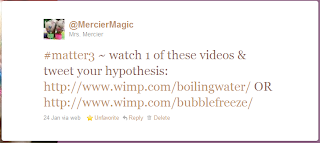Say Something
November 17th, I briefly attended Quinipiac University's New Vistas 2012 Conference. It was a WAC, or Writing Across the Curriculum Conference. It was a conference designed for college professors to get them involved in conversations about to improve the writing of college students. Here's the thing...I always enjoy going to conferences even if they don't directly relate to me because I inevitably take ideas from them that can be applied and/or modified to what I am currently doing. I found this to be true of this conference as well.
There is an interactive strategy that I use with my students and workshop participants called Say Something. It's a great strategy that requires each participant in a group to say something (just one thing) about a particular topic, text, or media. What I love about this strategy is the challenge to say only one thing, not get involved in a conversation, and how it requires all of the participants in the group to listen to each other. I also like how group participants can choose what kind of comment to make: personal connection, summary, an important idea, ask a question, reflection, answer or respond to another group participants comment. My tweet from the conference is below:
Love this idea!Adapting interactive strategy 'Say Something' to collaboratively respond to text. #newvistas12
— Tracy Mercier (@vr2ltch) November 17, 2012
I can't recall which speaker shared an alternative version of this strategy. I am thinking that it was either Dr. Anita August from Sacred Heart University, Lori Vaughn or Shelia Foley from Bay Path College (it was a panel-ish discussion). During the panel they had each spoken of how you can not elevate someone's writing without elevating their reading. When they are able to critically think about text then they are able to engage in writing that demonstrates critical thinking.
This professor engaged the students in reading a variety of texts. Each student would have a text in front of them and a pen in hand. (I remember this is how I was taught to critically read in high school.) They read the text they have in front of them and mark it up. They jot down one question, connection, reflection, etc. on the text. Then they pass the text to the next person in their group. They read it and do the same, but they also read what was previously written. This allows them to view each others' view points as well as to build upon each others' ideas. I loved this and thought it was a great way to get readers involved in a piece!
Imagine how powerful this would be to do with poetry! A brief memoir (I immediately think of Eloise Greenfield) would also be ideal for this As would any short biography or informational piece. Think of the Guinness World Record books or Myth Busters! Imagine bringing those into your unit of science study and involving the kiddos into critical literacy using this structure! It would definitely provide another avenue for kiddos to have their voice heard.
Yet, I can also picture it being used in a blog, Facebook Timeline, Twitter stream, or YouTube or Pinterest comment thread as well. Imagine posting a video on YouTube and having the kiddos saying one thing in the comment area, being limited to these criteria. How about posting an excerpt or quote on Facebook and having the kiddos engage in the Say Something structure? Retweeting something a scientist or author has tweeted and having the kiddos respond to it with the Say Something structure? Even a blog or Pinterest would allow them to do the same. Not only would this engage them in critical literacy, but it would also engage them in digital citizenship; practicing the necessary skills of digital etiquette.

Comments
Post a Comment